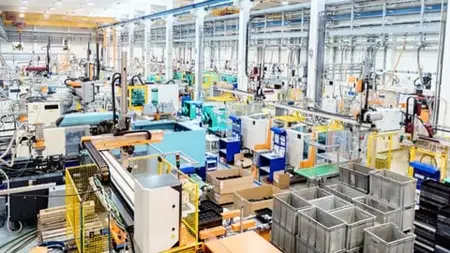Generative Ai For Production Planning Professionals
Published 8/2025
MP4 | Video: h264, 1920x1080 | Audio: AAC, 44.1 KHz
Language: English | Size: 334.17 MB | Duration: 2h 18m
Published 8/2025
MP4 | Video: h264, 1920x1080 | Audio: AAC, 44.1 KHz
Language: English | Size: 334.17 MB | Duration: 2h 18m
1000+ Prompts for Daily Decisions in Production Planning
What you'll learn
Identify how AI bridges gaps in conventional production planning methods.
Learn how Generative AI transforms data into production intelligence.
Use over 1000 expert-level prompts to automate every stage of planning.
Apply zero-shot, one-shot, and few-shot prompting for planning tasks.
Design instructional and analytical prompts for accurate production insights.
Create chained prompts to simulate end-to-end planning workflows.
Implement AI-driven trend, moving average, and seasonal forecasting.
Simulate demand surges, variability, and customer-specific scenarios.
Adjust forecasts dynamically based on real-time market conditions.
Track forecast accuracy and initiate automated correction loops.
Understand MPS fundamentals and their central role in planning.
Build weekly and monthly production schedules with AI prompts.
Resolve schedule conflicts and overloads using AI prioritization.
Adjust MPS dynamically using AI feedback from MES and IoT.
Generate AI-driven BOM explosions and procurement recommendations.
Perform shortage analysis and generate replenishment triggers with prompts.
Simulate what-if MRP scenarios and material flow outcomes.
Reschedule MRP operations intelligently based on delay recovery logic.
Understand the difference between finite and infinite capacity models.
Use AI to balance shop load across multiple production centers.
Detect capacity bottlenecks early and plan mitigation strategies.
Automate forward/backward capacity planning using AI tools.
Apply dispatch rules via AI for real-time execution accuracy.
Integrate live status updates from MES and IoT into planning decisions.
Optimize inventory levels with AI-generated safety stock and EOQ values.
Balance stock intelligently across multiple plant and warehouse locations.
Factor warehouse space constraints into scheduling decisions using prompts.
Analyze cycle count deviations and generate adjustment proposals.
Detect risks in production plans using prompt-based risk assessments.
Generate scenarios for machine breakdowns, supplier issues, or demand spikes.
Create AI-driven contingency plans like line activation or load shifting.
Design lean recovery workflows after production disruptions.
Draft executive-level narratives explaining the production plan clearly.
Requirements
A foundational understanding of production and manufacturing workflows.
Description
This course, "Generative AI for Production Planning Professionals," offers an in-depth exploration of how modern AI techniques—particularly generative AI—are revolutionizing production planning. It begins by laying strong foundations through core concepts, planning objectives, and the distinctions between strategic, tactical, and operational planning. Participants will gain insights into the evolution from traditional planning approaches to AI-augmented systems that drive precision and agility. Special emphasis is placed on the role of generative AI, including advanced prompting methods such as zero-shot, one-shot, and few-shot techniques, instructional and analytical prompts, and prompt chaining for sequential logic building.Learners will delve into AI-enhanced forecasting techniques that include trend-based, moving average, seasonal, and dynamic demand adjustments driven by real-time market signals. The course also focuses on ensuring forecast accuracy through monitoring and correction loops. It then transitions into Master Production Scheduling (MPS), showing how AI supports weekly and monthly planning, overload resolution, and real-time adjustments via feedback loops. In material planning, topics include BOM explosion automation, shortage analysis, and AI-driven what-if simulations for rescheduling and delay recovery.Capacity planning is comprehensively addressed, covering finite/infinite modeling, shop load balancing, bottleneck resolution, and dispatch rules. Students will also explore IoT and MES integrations for real-time insights, and inventory optimization through AI-generated safety stock, reorder point, and warehouse balancing prompts. Risk assessment, scenario simulations, and contingency plan generation form a key part of the curriculum, preparing professionals to handle uncertainty with confidence.Finally, the course empowers learners with capabilities in narrative generation, KPI dashboard creation, audit traceability, and planning justification. With over 1000 expert prompts, the course equips participants with practical tools to apply AI across every facet of production planning, making it an essential training for forward-thinking professionals aiming to lead in Industry 4.0 environments.
Overview
Section 1: Introduction
Lecture 1 Introduction - Core Concepts of Production Planning
Lecture 2 Generative AI in Context of Production Planning
Lecture 3 Course Setup - Downloadable files
Section 2: Mastering Prompt Engineering in Production Context
Lecture 4 Zero-shot, one-shot, few-shot prompting using production data
Lecture 5 Instructional and analytical prompting
Lecture 6 Prompt Chaining
Section 3: Demand Forecasting and Sales Planning with AI
Lecture 7 Forecasting Methods Enhanced by AI
Lecture 8 Generative Prompts for Scenario-Based Forecasting
Lecture 9 Dynamic Forecast Adjustments Based on Market Signals
Lecture 10 Forecast Accuracy Monitoring and Correction Loops
Section 4: Master Production Scheduling (MPS) with Generative AI
Lecture 11 Fundamentals of MPS and its Role in Production Planning
Lecture 12 AI-Based Weekly and Monthly Scheduling Models
Lecture 13 Managing Conflicts and Overloads with Generative AI
Lecture 14 Monitoring and Adjusting MPS in Real-Time with AI Feedback
Section 5: Material Requirement Planning (MRP) with AI
Lecture 15 AI-Enhanced BOM Explosion and Procurement Timing
Lecture 16 Shortage Analysis and Replenishment Recommendations
Lecture 17 What-if Simulation for MRP Scenarios
Lecture 18 AI-Driven MRP Rescheduling with Delay Recovery Plans
Section 6: Capacity Planning and Resource Utilization
Lecture 19 Finite vs Infinite Capacity Planning
Lecture 20 Shop Load Balancing with Generative AI
Lecture 21 Capacity Bottleneck Identification and Resolution
Lecture 22 Forward/Backward Capacity Planning Automation
Section 7: Shop Floor Control and Dispatching Prompts
Lecture 23 AI-Driven Dispatch Rules for Real-Time Execution
Lecture 24 Live Status Updates from MES and IoT Integration
Section 8: Inventory Control and Warehouse Sync
Lecture 25 Inventory Optimization Using AI-Generated Insights
Lecture 26 Prompts for Stock Balancing Across Locations
Lecture 27 Warehouse Constraints in Production Planning
Lecture 28 Cycle Count Analysis and Adjustment Proposals
Section 9: Disruption Management and Scenario Planning
Lecture 29 Prompting AI to Identify Planning Risks
Lecture 30 Scenario Generation: Machine Failure, Delay, Demand Spike
Section 10: Narrative Generation
Lecture 31 Narrative Generation: Explaining the Production Plan to Leaders
Section 11: 1000+ Prompts- Generative AI for Production Planning
Lecture 32 Production Planning from Sales Forecasts
Lecture 33 Monthly Capacity Planning and Line Allocation
Lecture 34 Product Mix Optimization
Lecture 35 Bottleneck Resource Allocation
Lecture 36 Make-to-Order vs Make-to-Stock Prompt Logic
Lecture 37 Weekly Scheduling Based on Priority and Capacity
Lecture 38 Changeover Optimization and Setup Time Minimization
Lecture 39 AI-Driven Sequencing for Multi-Product Lines
Lecture 40 Preventive Maintenance Window Planning
Lecture 41 Alternate Routing for Work Orders
Lecture 42 BOM Explosion and Net Requirement Calculation
Lecture 43 Material Availability Checks Before Scheduling
Lecture 44 AI-Based Purchase Requisition Timing
Lecture 45 Substitute Material Planning
Lecture 46 MRP Exception Handling (Shortages, Delays)
Lecture 47 Sales Trend-Based Forecasting
Lecture 48 Moving Average and Weighted Forecasts
Lecture 49 Forecast Recalibration Based on Real Demand
Lecture 50 Seasonal and Cyclic Demand Forecasting
Lecture 51 Simulation of Demand Spike or Drop
Lecture 52 Inventory Level Monitoring Prompts
Lecture 53 Safety Stock Recalculation
Lecture 54 Reorder Point and EOQ Analysis
Lecture 55 Inter-plant Transfer Suggestions
Lecture 56 Warehouse Space Constraints in Scheduling
Lecture 57 Finite vs Infinite Capacity Models
Lecture 58 Load Balancing Between Work Centers
Lecture 59 Labor and Machine Shift Matching
Lecture 60 Real-Time Capacity Overload Handling
Lecture 61 Dynamic Shop Floor Workload Analysis
Lecture 62 Daily Production Summary Report Generation
Lecture 63 OTIF and Schedule Adherence Dashboards
Lecture 64 Scrap and Rework Trend Analysis
Lecture 65 Machine Utilization KPIs via Prompting
Lecture 66 Production Variance Explanation Generator
Lecture 67 AI Alerts for Missed Deliveries or WOs
Lecture 68 Risk-Based Prioritization of Work Orders
Lecture 69 Disruption Simulation (machine, supplier, demand)
Lecture 70 Emergency Replanning After Failures
Lecture 71 Lean Recovery Planning from Downtime
Lecture 72 Production Plan Narratives for Executives
Lecture 73 Planning Justification Memos (why X was prioritized)
Lecture 74 Handoff Reports to Maintenance and QA Teams
Lecture 75 Real-Time Shop Floor Bulletins
Lecture 76 Email or Chat Summary Generators for Shift Changes
Lecture 77 Historical Data Pattern Analysis via Prompts
Lecture 78 Continuous Improvement Suggestions from AI
Lecture 79 Model Retraining via Feedback Loops
Lecture 80 KPI-Based Recalibration Prompts
Lecture 81 Planning Audit Trail and Traceability Prompts
Production Planners looking to automate scheduling, MRP, and capacity tasks using AI prompts,Operations Managers aiming to integrate AI into real-time shop floor decision-making,Manufacturing Engineers seeking to simulate production scenarios and optimize workflows,Supply Chain Analysts who want to align planning with inventory and procurement using AI,Demand Planners needing AI-driven forecasting, seasonal analysis, and signal-based adjustments,Industrial Engineers interested in prompt-based workload distribution and load balancing,ERP Specialists and MES users wishing to extend existing systems with AI augmentation,Quality Managers and Maintenance Heads who rely on synchronized planning inputs,Professionals transitioning into Smart Manufacturing and Industry 4.0 roles,Executives and Digital Transformation Leaders overseeing AI implementation in planning



